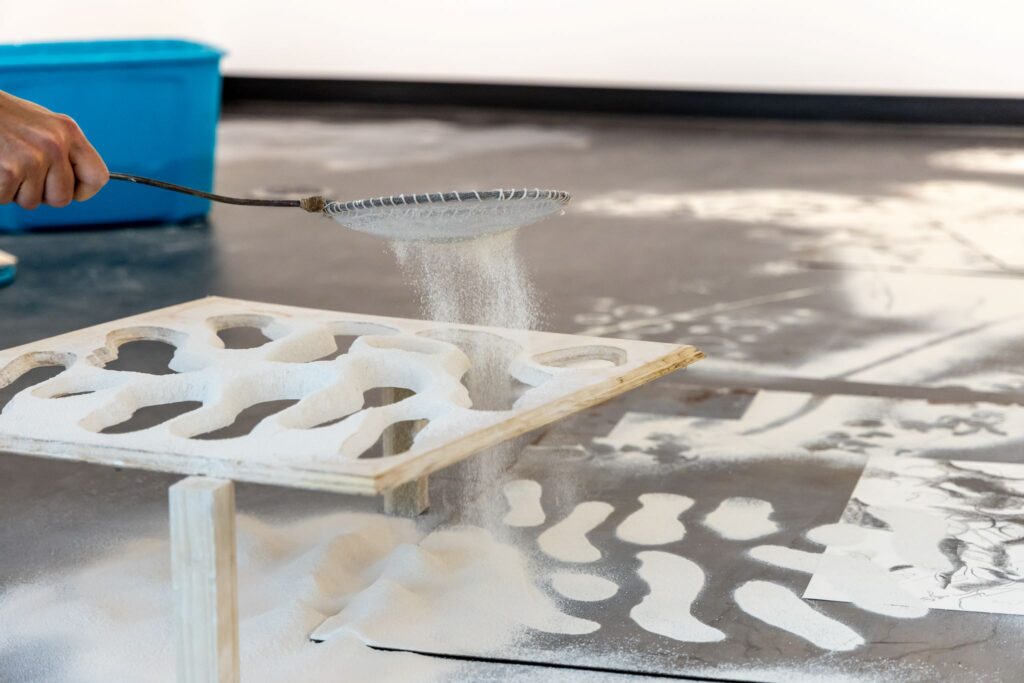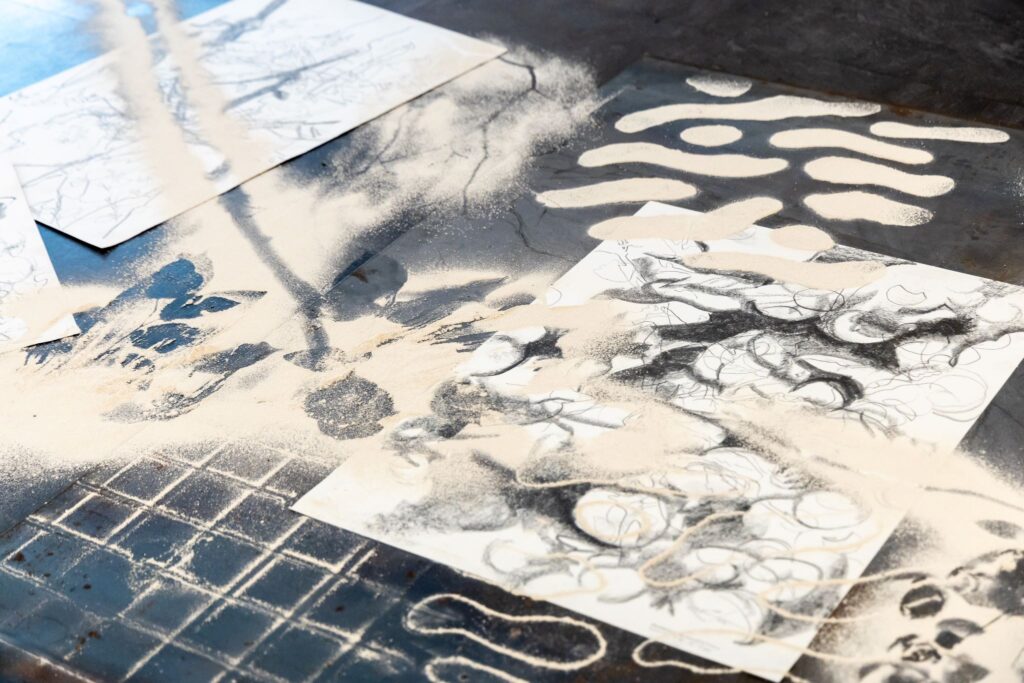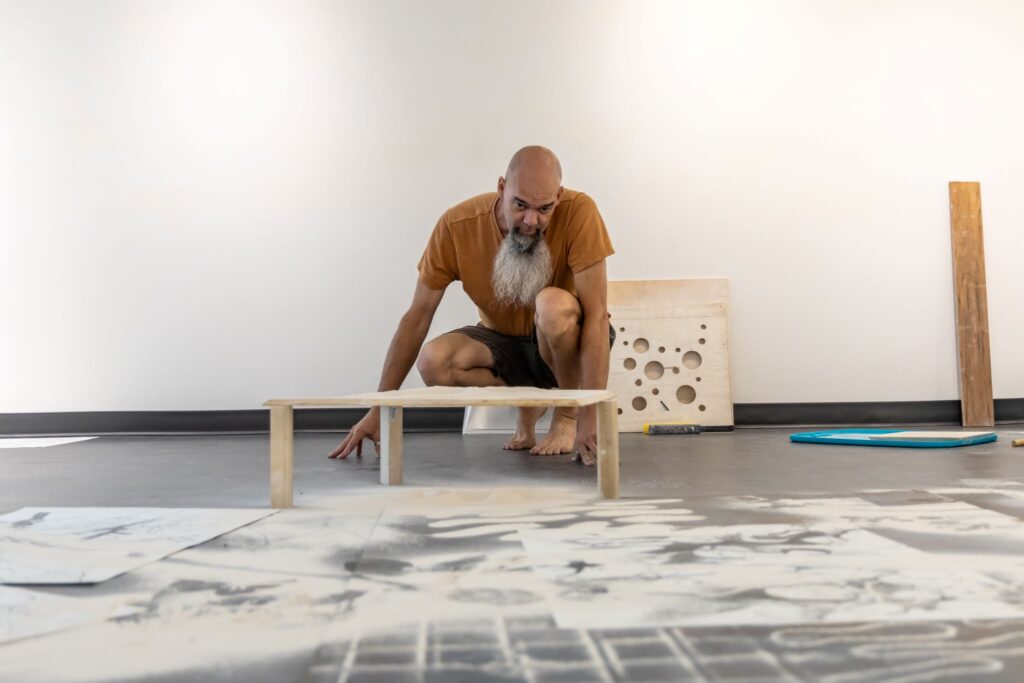Art can be found in many places on Bridgewater College’s campus, but its hub is arguably the Beverly Perdue Art Gallery in the John Kenny Forrer Learning Commons. There, rotating exhibitions showcase works produced by visiting artists and members of the BC community, including students and faculty.
Yet this summer, from June 6 through Aug. 15, the gallery space looks different from what one might expect. Instead of artwork hanging on the walls, graphite drawings lie on the floor as Associate Professor of Art Eric Kniss hovers over, sifting a fine powder called kaolin on top. With tools and other materials scattered nearby, the space feels more like a workshop than a gallery, and Kniss hopes visitors will stop by and ask questions.
“There’s something about having people in the space while I’m [working] that seems intriguing to me,” Kniss said, adding that he enjoys the challenge of creating art while being observed.
In addition to exploring the performative aspect of art by enabling visitors to interact directly with the artist, Kniss is experimenting by combining two mediums, drawings and sifted kaolin sculptures. He began working with kaolin as a graduate student at UNC Greensboro after he observed snow accumulating on a trash can during the winter. Intrigued by how the shape of the snow build-up was influenced by the snow’s intrinsic properties and the nature of the surface it landed on, Kniss sought out a material he could use to recreate this effect.

Initially, Kniss chose kaolin because of its soft white color, although he has grown to appreciate other qualities like its soft texture, stability and the steep angles of repose it creates in his sculptures. He also values the effort and time involved in sifting kaolin to create different shapes, patterns and designs.
“For me, the act of making something is in some ways more important than the thing itself,” Kniss said.
To some, these kaolin sculptures may challenge traditional expectations of art, in part because the sculptures are impermanent. Unlike paintings or even Kniss’ drawings, when the time comes to take the exhibit down, the kaolin will be swept up and the sculptures will cease to exist. Kniss views this ephemerality as a prompt to question our ideas around permanence and how we assign value to various forms or objects as a result.
“Nothing is ever permanent. I’m just shortening the lifespan,” Kniss said.
The notion of place also factors into Kniss’ work, particularly his drawings. Being a third culture kid who grew up in India before his parents returned “home” to the United States when he was 8 years old made it difficult to develop a sense of belonging in the world.
“That experiential reality is deeply rooted in that sense of ‘what is the world, and where do I fit in it,’” Kniss explained. “And that’s why this idea of making something is so important to me as a person being in the world…I’m standing on the surface of the planet, responding in the moment to light, shadow, wind. That interaction articulates my presence.”
Guided in part by this emphasis on place, Kniss is intrigued by how boundaries – like borders between countries, for example – are clear and distinct in our minds, yet in practice, they tend to be blurred and vague. In his current work, this dichotomy of boundaries seems to show itself in how the kaolin interacts with the drawings beneath. At times, the kaolin forms sharp lines and angles or completely obscures parts of the drawings, while at others, the kaolin and marks of graphite on the drawings weave together, with the kaolin’s color blending into that of the paper.

At this point in his residency, Kniss is still experimenting with the kaolin and drawings and said that he has no idea what the end result will look like. He emphasizes the creative journey, and he encourages others to accompany him on this journey by visiting the gallery and engaging with him and the art. “Come on by! Don’t be scared. The work is delicate but not fragile, and I’m not fragile with it,” Kniss said. “Don’t be afraid to poke or dig.”
– Eli Quay


